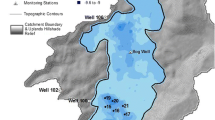Abstract
The elemental (including silica (Si), calcium (Ca), magnesium (Mg), manganese (Mn) and iron (Fe)) and nutrient composition of peatland surface pools and concentrations of Ca, Mg, Mn, and Fein peat interstitial waters and surface peat concentrations of oxides of Mn and Fe were determined for 15 peatlands sampled along a mineral gradient. Surface pool concentrations of Si wereca. ten fold less in surface pools of mineral-poor peatlands thanin the mineral rich, supporting the use of this element as an indicator of minerotrophic influence in peatlands. Principle component analysis of surface pool water chemistry parametersdifferentiated mineral-poor and moderately-poor peatlands frommineral-rich peatlands based on the concentrations of Ca, Mgand alkalinity of pools. Several lines of evidence indicated that peatland interstitial waters were important contributors to peatland alkalinity and included; (1) maximum interstitial water concentrations of Ca and Mg correlating with overlying surface pool alkalinity, (2) a negative correlation between interstitial water Ca:Mg ratios and surface pool concentrationsof Si and (3) Ca:Mg ratios of moderately-poor to mineral-poorpeatland interstitial waters approaching the Ca:Mg ratio of rainwater rather than those of bedrock. Interstitial water concentrations of dissolved Mn and Fe correlated with amountsof reducible Fe and Mn (oxides of Fe and Mn) recovered from thepeat/water interface indicating that groundwater inputs areimportant sources of these two elements to fens. As a consequence, for peatlands that are not truly ombrotrophic,groundwater inputs of Mn and Fe may interfere with interpretingpeat metal profiles thought to be due to anthropogenic inputs alone.
Similar content being viewed by others
References
Bendell-Young, L. I.: 1998, 'Contrasting the sorption of Zn by peats along a mineral-poor to mineralrich fen gradient', Appl. Geochem. 14, 719–734.
Bendell-Young, L. I. and Pick, F. R.: 1997, 'Base cation composition of interstitial, peat and pool water of 15 Ontario peatlands: Implications for peatland acidification', Water, Air, and Soil Pollut. 96, 155–173.
Bendell-Young, L. I., Dutton M. and Pick, F. R.: 1992, 'Contrasting two methods for determining trace metal partitioning in surface sediments', Biogeochemistry 17, 15–29.
Carignan, R.: 1984, 'Interstitial water sampling by dialysis: Methodological notes', Limnol. Oceanogr. 29, 667–670.
Clausen, J. C. and Brooks, K. N.: 1983, 'Quality of runoff from Minnesota peatlands: I. A characterization', Wat. Res. Bull. 19, 763–135.
Environment Canada: 1979, Analytical Methods Manual, Vol. I. Inland Water Directorate, Water Quality Branch, Ottawa, Ontario.
Girard, R., Reid, R. A. and Snyder, W. R.: 1985, 'The Morphometry and Geology of Plastic and Heney Lakes and their Catchments', Data Report 85/1, Ontario Ministry of the Environment.
Harvey, H. H., Pierce, R. C., Dillon, P. J., Kramer, J. R. and Whelpdale, D.M.: 1981, Acidification in the Canadian Aquatic Environment, National Research Council of Canada, Ottawa. NRCC Publ. No. 18475, 369 pp.
Hesslein, R. H.: 1976, 'An in situ sampler for close interval interstitial studies', Limnol. Oceanogr. 21, 912–914.
Hill, B. M. and Siegel, D. I.: 1991, 'Groundwater flow and the metal content of peat', J. Hydrol. 123, 211–224.
Jeffries, D. S. and Snyder, W. R.: 1983, 'Geology and Geochemistry of the Muskoka-Haliburton Study Area', Data Rep. DR 83/2, Dorset Research Center, Dorset, Ontario, Canada.
Kivinen, E. and Pakarinen, P.: 1981, 'Geographical distribution of peat resources and major peatland complex types in the world', Ann. Acad. Sci. Fennicae A. III, 132.
Mitsch, J. W. and Gosselink, J. G.: 1986, Wetlands, Van Norstrand Reinhold Co., New York, 539 p.
SAS Institute Inc.: 1988, SAS/STAT User's Guide, Release 6.03 Edition. Cary, NS: SAS Institute Inc., 1988, 1028 p.
Shotyk, W., Cheburkin, A. K., Appleby, P. G., Fankhauser, A. and Kramers, J. D.: 1996, 'Two thousand years of atmospheric arsenic, antimony, and lead deposition recorded in an ombrotrophic peat bog profile, Jura Mountains, Switzerland', Earth Planet. Sci. Lett. 145, 1–4.
Shotyk, W.: 1988, 'Review of the inorganic geochemistry of peats and peatland waters', Earth Sciences Rev. 25, 95–176.
Steinmann, P. and Shotyk, W.: 1997, 'Chemical composition, pH, and redox state of sulfur and iron in complete vertical porewater profiles from two Sphagnum peat bogs, Jura Mountains, Switzerland', Geochim. Cosmochim. Acta 61, 1143–1163.
Tolonen, K. and Hosiaisluoma, V.: 1978, 'Chemical properties of surface pools in Finnish ombrotrophic mire complexes with special reference to algal growth', Ann. Bot. Fenn. 15, 55–72.
Verry, E. S.: 1975, 'Streamflow chemistry and nutrient yields from upland-peatland watersheds in Minnesota', Ecology 56, 1149–1157.
Zoltai, S. C.: 1988, Ecological Land Classification, Series No. 24, Polyscience Pub. Inc., Montreal, Quebec, 452 pp.
Author information
Authors and Affiliations
Rights and permissions
About this article
Cite this article
Bendell-Young, L. Peatland Interstitial Water Chemistry in Relation to that of Surface Pools along a Peatland Mineral Gradient. Water, Air, & Soil Pollution 143, 363–375 (2003). https://doi.org/10.1023/A:1022865109409
Issue Date:
DOI: https://doi.org/10.1023/A:1022865109409




